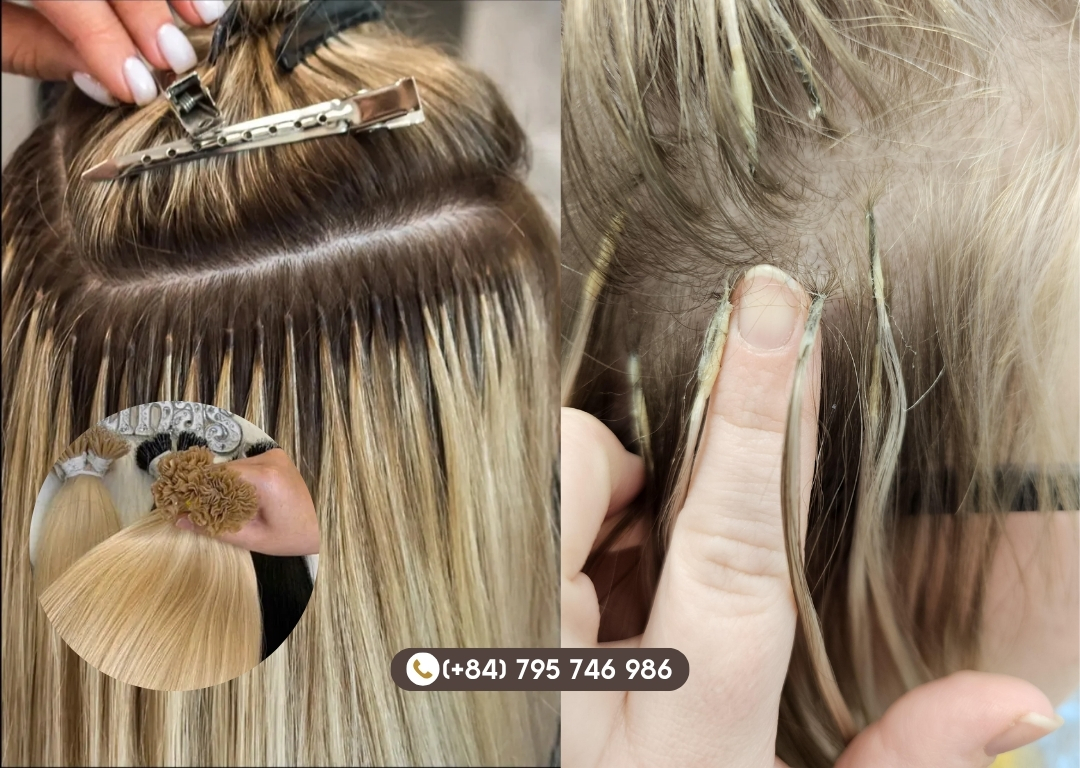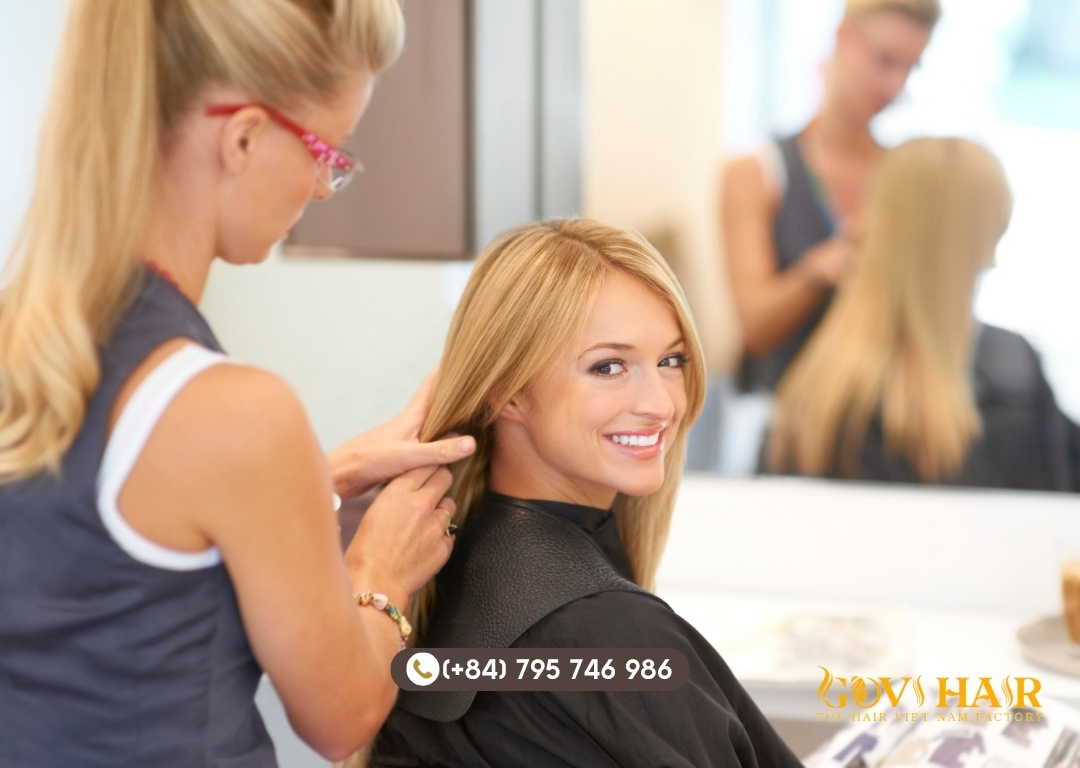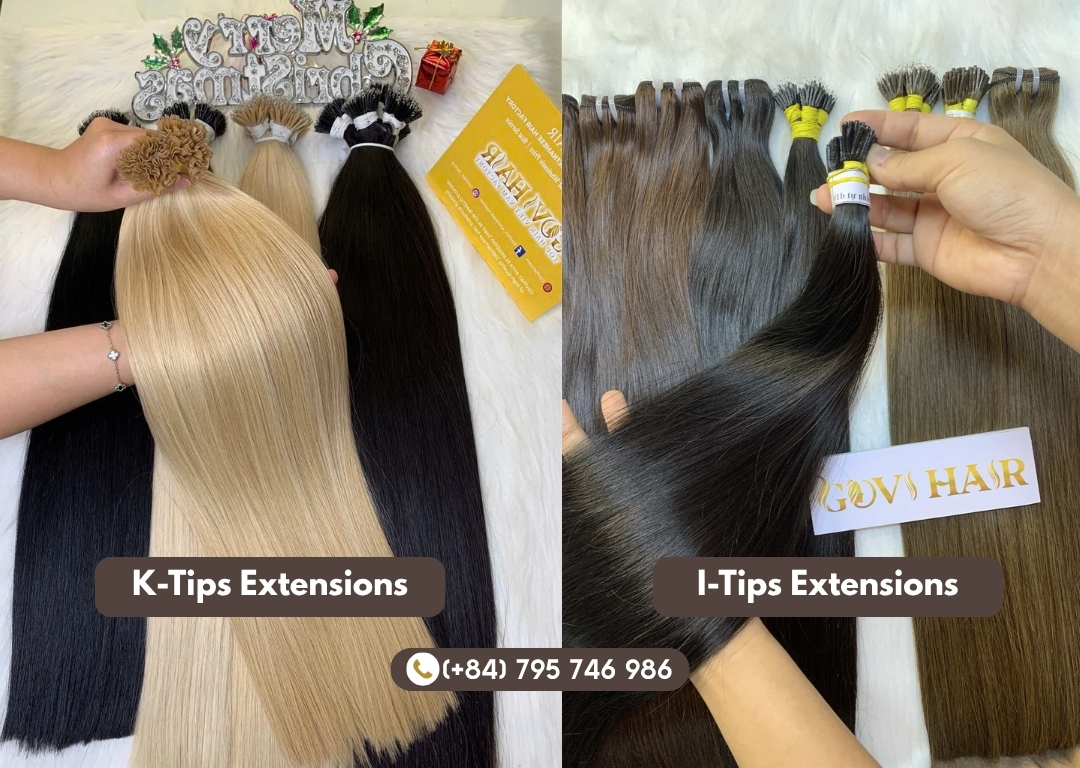Nowadays, K-Tip hair extensions have become a go-to choice for anyone chasing extra length, volume, or just that glam vibe without giving away their secret. They blend so well that most people won’t even realize you’re rocking extensions. But here’s the catch — while they look amazing and can last for months, the real question is about your own hair’s safety. Do K-Tip extensions damage hair, or is that just another beauty myth? In this article, GoviHair will help you break down exactly what K-Tip extensions are, how they’re installed, and most importantly — whether they’re safe for your natural hair.
What Are K-Tip (Keratin Tip) Extensions?
K-Tip extensions, also called keratin tip or fusion extensions, are strands of human hair bonded to your natural hair using a keratin-based adhesive. The keratin bond is heated and fused to small sections of your hair, creating a seamless and long-lasting look.
Because the keratin tips mimic the protein in natural hair, they blend easily and feel lightweight. With the right installation, K-Tips can last 3–5 months, making them one of the most durable extension methods available.

>>Learn More: What are Fusion Hair Extensions? Information You Need to Know
Do K-Tip Extensions Damage Hair?
The answer is: It depends.
K-Tips themselves don’t “automatically” ruin your hair, especially when applied and removed correctly by a professional. Hence, they can be perfectly safe and even suitable for long-term wear. However, if installed poorly or not cared for properly, they can cause breakage and scalp irritation.
So, whether K-Tips are a hair dream or hair nightmare comes down to the details of how they’re used.
How K-Tip Extensions Could Damage Hair?
When K-Tips Extensions Are Safe?
When K-Tips hair extensions are processed safely, it will not cause any unintentional damages on your hair. However, this requires relentless effort from both you and your hair stylist.
- Applied by professionals: A skilled stylist ensures bonds are placed evenly, avoiding tension spots that lead to traction alopecia.
- Healthy natural hair: If your hair is strong and not overly processed, the keratin bonds won’t weaken it.
- Proper aftercare: Using sulfate-free shampoos, avoiding tugging, and following a care routine helps maintain both your hair and the extensions.
- Timely removal: Following the correct K-Tip removal process prevents unnecessary pulling or breakage.

When K-Tip Extensions Cause Damage?
On the other hand, K-Tip extensions break hair heavily if it is handled poorly or unsuitable.
- Thin or fragile hair: Many ask, “Are K-Tip extensions bad for thin hair?” Yes, because the bonds add weight that can pull on already weak strands.
- Incorrect installation: Too much heat or uneven placement can cause breakage and scalp burns.
- Prolonged wear: Leaving them in longer than the recommended lifespan of K-Tip extensions can cause matting and damage.
- DIY removal: Pulling or peeling bonds without the right solution can ruin your natural hair.
>> Read More: K tip Hair Extensions Pros and Cons
Which Hair Types Are Most Suitable With K-Tip Extensions?
K-Tip extensions can blend beautifully with many hair types, but they’re not suitable for everyone. Applying them on the wrong hair type may lead to unnecessary stress and damage. Consider these cases as a reference when choosing your suitable hair extension.
K-Tip Extension is ideal for :
- Medium to thick hair types.
- Healthy, non-brittle strands.
- People who want long-term wear with minimal salon visits.
K-Tip Extension is not ideal for:
- Very fine or thinning hair (risk of breakage).
- Extremely damaged or chemically treated hair.
- Anyone prone to scalp irritation.

The Best Care Routine for K-Tips Extensions to Avoid Hair Damage
Following this routine prevents K-Tip extensions from breaking hair and helps maintain your natural locks.
- Gentle Brushing: Use a loop brush or wide-tooth comb to detangle, starting from the ends and working your way up to the roots. This prevents slippage and hair breakage.
- Heat Management: Keep flat irons, curling wands, and blow dryers away from the keratin bonds. Excessive heat can weaken the adhesive and harm your natural hair.
- Washing & Products: Stick to sulfate-free shampoos and lightweight conditioners, avoiding heavy oils on the bonds. This keeps extensions soft and reduces tangling.
- Avoid Overloading: Don’t attach too many extensions at once. Allow your natural hair time to adapt to the extra weight. Overloading can cause hair thinning or breakage and make styling uncomfortable.
- Regular Maintenance: Schedule touch-ups every 6–8 weeks to reposition bonds and remove any that may have slipped. Proper maintenance maximizes the lifespan of K-Tip extensions and keeps your hair healthy.
>>Learn More: Hair Extension Maintenance: Why It’s Important And How To Do It Right
K-Tips vs I-Tips: Which Causes the Least Damage?
While using either K-Tip or I-Tip hair extensions is not inherently dangerous, it’s important to focus on which method is more suitable and safer for your hair.
- K-Tips (Keratin Tips): These are applied using heat to fuse a keratin bond to your natural hair. The result is, K-Tips usually stay in place longer and feel more secure.
- I-Tips (Beaded Extensions): Instead of heat, I-Tips are attached with tiny beads or micro-links. This method avoids heat damage, making it generally safer for fine or delicate hair types.

Ultimately, the best choice may depend on your hair type, lifestyle, and how much maintenance you’re willing to commit to. Let’s dive into the key differences between K-Tip and I-Tip extensions to see which suits you best.
| Feature | K-Tip | I-Tip |
| Method | Heat-fused keratin | Beads/micro-links, no heat |
| Best For | Medium/thick hair | Fine or fragile hair |
| Lifespan | 3–5 months | 2–3 months, may slip |
| Damage Risk | Heat & bond weight | Bead tension/slippage |
| Maintenance | Fewer touch-ups | More frequent adjustments |
How to Minimize Damage of K-Tips Extensions
Getting K-Tip extensions isn’t just about the look, it’s about protecting your natural hair. Pre and After care are key to preventing damage, keeping your extensions smooth, and ensuring your hair always stays healthy.
Professional Application: Always have K-Tip extensions installed and removed by a trained stylist. Professionals know how to space the bonds correctly, apply the right amount of heat, and prevent unnecessary tension on your natural hair. This reduces risks like traction alopecia, breakage, and scalp irritation.
Choose High-Quality Hair: It’s worth to note that not all K-Tips extensions are made from the same material. Low-quality K-Tips are often blended with synthetic fibers or fillers. While they might seem like a budget-friendly choice, these extensions tend to tangle easily and lose moisture. This might lead to breakage, thinning, and long-term damage to your natural hair.
That’s why GoviHair is committed to using only 100% natural Vietnamese hair, ensuring every strand is soft, strong, and completely tangle-free. This premium quality reduces the risk of breakage, protects your natural hair, and keeps it healthy and lustrous over time.

Our extensive range of keratin tip extensions from F-Tip to V-Tip, giving you options to match your desired style, length, and volume. Each strand is carefully processed and shaped to blend seamlessly with your own hair, delivering a natural, undetectable look. The result is not just a quick transformation, but long-lasting, salon-quality outcomes that make every before-and-after reveal truly stunning.
For inquiries and orders, feel free to reach out to Govihair through the following channels:
- WhatsApp: (+84) 795 746 986
- Email: [email protected]
- Instagram: govihair_vietnamhair_factory
- Tik Tok: govihairvietnam_official
- Website: govihair.com
FAQs
Can k-tip extensions ruin your natural hair?
K-Tip (keratin tip) extensions can damage hair if installed improperly or left too long, but when applied by a certified stylist with proper aftercare, the risk is minimal.
Are K-Tip extensions bad for thin hair or fragile hair?
Thin or fragile hair is more prone to traction alopecia and breakage. Stylists may recommend lighter extensions or alternatives like tape-in or micro-links.
How can I prevent hair damage from K-Tip extensions?
Use sulfate-free shampoo, avoid excessive heat, follow maintenance schedules, and never pull or twist bonds. Regular check-ins with your stylist help prevent shedding and slippage.
How long do K-Tip extensions last without causing damage?
Typically 3–6 months if installed correctly, with touch-ups every 6–8 weeks. Damage risk rises if extensions are left beyond their lifespan or removed improperly.
Are there alternatives to K-Tip extensions for safer hair?
Yes. Options like tape-in extensions, micro-links, or clip-ins are lighter and lower-risk for breakage, especially for people with thin or damaged hair.
Conclusion
So, do K-Tip extensions damage hair? The truth is, they don’t have to. When installed by a professional, properly maintained, and removed correctly, K-Tips can be a safe and stylish way to enhance your hair. By understanding these key facts and following expert techniques to prevent unintentional damage, readers can enjoy the beauty and versatility of extensions while keeping their natural hair healthy and strong.









 Ms. Victoria
Ms. Victoria